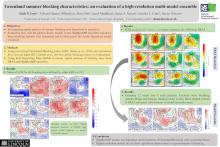Greenland summer blocking characteristics: an evaluation of high resolution multi-model ensemble
Linh
Luu
Department of Geography, University of Lincoln, UK
Poster
Atmospheric blocking is a phenomenon that can lead to extreme weather events over a large region and hence, it is of significant scientific and societal interest. The causes of blocking are not well understood. Climate models show limitations in representing Northern Hemisphere blocking, especially its frequency, but also potentially in trends in summertime blocking over Greenland in the last few decades. In this study, we evaluate the ability of high-resolution coupled climate models from HighResMIP to simulate summer Greenland blocking, using several complementary methods describing the different characteristics of blocking. We find that the HighResMIP ensemble can reproduce the spatial pattern of Greenland blocking, albeit with systematic bias, and capture the proportions of 3 main blocking types: namely, the wave breaking structure, North Atlantic ridge, and omega-type blocking. However, HighResMIP ensemble fails to simulate the temporal variations of Greenland blocking) and the extreme tail of statistical distribution of the daily blocking index. In addition, higher-resolution HighResMIP models do not show improved representation of blocking features, compared with lower-resolution HighResMIP models.

Poster file
LinhLuu_Poster_Blocking-Workshop.pdf
(1.21 MB)
Meeting homepage
